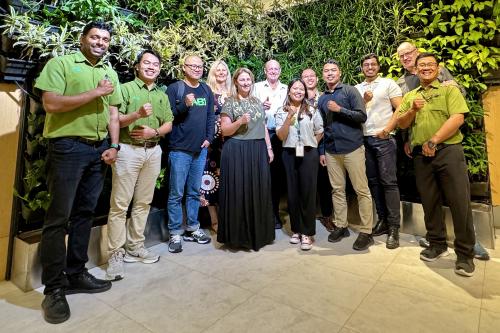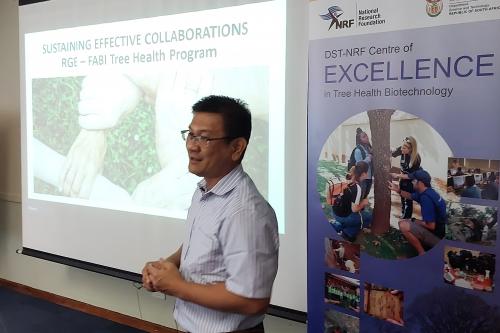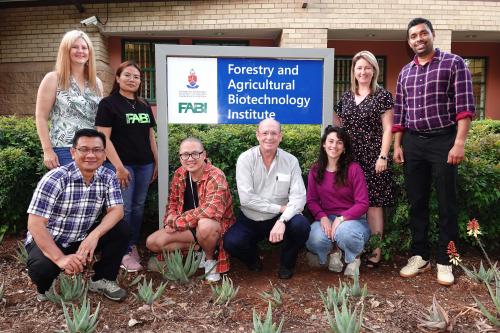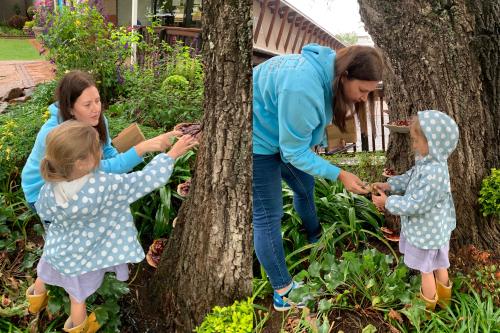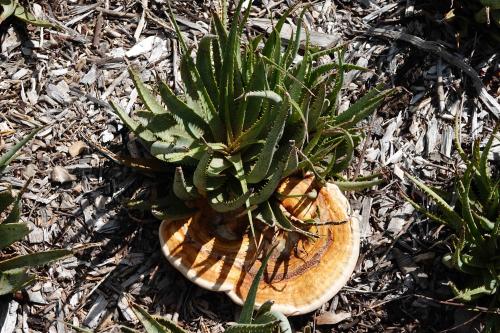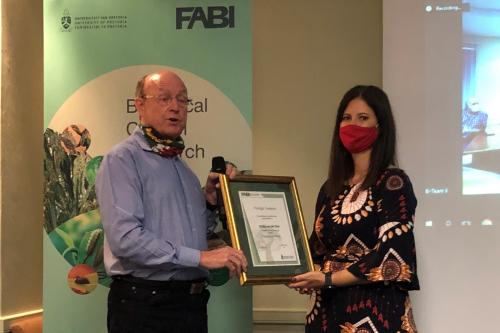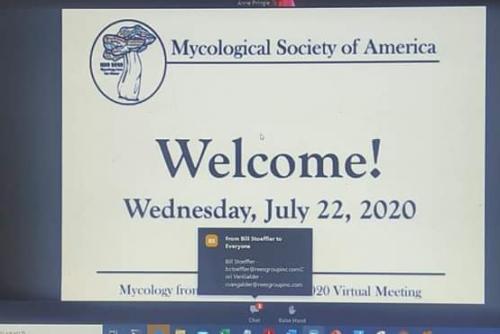Dr Ariska van der Nest
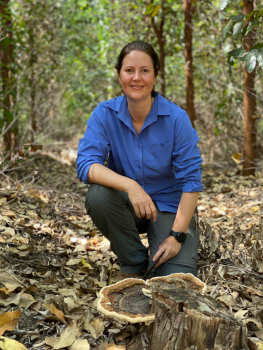
| Postdoctoral Fellow | |
Department |
|
Biochemistry, Genetics and Microbiology |
|
| This email address is being protected from spambots. You need JavaScript enabled to view it. |
I joined the RGE-FABI Tree Health Programme in January 2022 as a Postdoctoral Fellow. My research will focus on Ganoderma root rot in Indonesian plantations.
I completed my PhD in 2021 as part of the Tree Protection Co-operative Programme (TPCP). Dothistroma needle blight (DNB), caused by Dothistroma pini and D. septosporum, and Brown spot needle blight (BSNB), caused by Lecanosticta species, are two needle diseases of Pinus species that have become diseases of emerging importance in the northern Hemisphere in the past twenty years. My PhD project focused on the diversity and invasion biology of these two important pine needle pathogen genera.
As a part of my PhD, I identified six species of Lecanosticta, of which four are novel taxa, from a large collection of Lecanosticta isolates from infected pine needles from Guatemala, Honduras and Nicaragua based on sequence comparisons of five gene regions. The well-known pathogen, L. acicola was not present in any of the samples investigated in my studies, indicating that this might be a Northern Hemisphere pathogen. It was concluded that due to the high species diversity of Lecanosticta in Mesoamerica, that this region is considered a centre of diversity for the genus.
Dothistroma needle blight is caused by two morphologically indistinguishable species, Dothistroma pini and D. septosporum. Dothistroma septosporum has a worldwide occurrence while D. pini has only been recorded in the Northern hemisphere. I also investigated the population diversity, structure and mode of reproduction and likely means of spread for a large collection of D. pini obtained from 12 countries in Europe over a 12-year period. The observed population structure as well as several shared multilocus haplotypes between non-bordering countries provides evidence that the occurrence and spread of D. pini on the continent has been strongly influenced by human mediated activities in Europe.
The final part of the study addressed the unprecedented DNB outbreaks observed in Cantabria in Spain, in 2015, by determining the causal agent, and determined the population structure, genetic diversity and mode of reproduction of the pathogen involved, from three infected sites of planted Pinus nigra subspecies. Dothistroma septosporum was confirmed as the causal agent and the high genetic diversity observed in isolates obtained from Cantabria suggested that the pathogen was not recently introduced into the region.
Presentations and Posters
van der Nest, A., Wingfield, M.J., Sadiković, D., Mullett, M., Queloz, V., Adamčíková, K., Davydenko K., Barnes, I. 2020. Population structure and diversity of Dothistroma pini in Europe suggests human mediated movement of the needle blight pathogen. MSA 2020 'Mycology from the Clouds' virtual meeting. Graphical abstract.
van der Nest, A., Wingfield, M.J., Barnes, I. 2018. The rising threat of novel pine needle pathogens from Central America under expanding global cultivation. 44th Conference of the South African Association of Botanists, 9-12 January 2018, Pretoria, South Africa. p91.
Barnes, I., van der Nest, A., Ortiz, P., Wingfield, M. 2017. New cryptic species and a putative center of diversity for the pine pathogens Dothistroma and Lecanosticta. IUFRO 125th Anniversary Congress, 18-22 September 2017, Freiburg, Germany. p221.
van der Nest, A., Wingfield, M.J., Barnes, I. 2017. Diversity of Lecanosticta species in Central America suggests a centre of diversity for an important group of pine needle pathogens. 50th Anniversary Congress of the Southern African Society for Plant Pathology, 15-18 January 2017, Champagne Sports Resort, Drakensberg. Poster 26.
van der Nest, A., Wingfield, M.J., Barnes, I. 2016. The phylogenetic diversity of Lecanosticta in Central America suggests a centre of diversity for this genus. 4th Joint congress of the SA Society for Bioinformatics and the SA Genetics Society, 20-23 September 2016, Durban, South Africa. p35
van der Nest, A., E.T. Steenkamp & G.J. Marais. 2009. Phylogenetic relatedness of Phoma sorghina as a mycotoxigenic fungus in South Africa. International Society for Mycotoxicology conference, 9-11 September 2009, Tullin, Austria.
van der Nest, A., Steenkamp, E.T., Marais, G.J. 2009. Phylogenetic definition of Phoma sorghina based on the ITS, EF-1α and β-tubulin gene regions. 46th Congress of the Southern African Society for Plant Pathology and 6th Congress of the African Mycological Association (AMA), 25 – 28 January 2009, Villa Via Hotel, Gordon’s Bay, South Africa. p110.
van der Nest, A., Steenkamp, E.T., Marais, G.J. 2008. Phylogenetic diversity of Phoma sorghina in Southern Africa. Biennial Conference of the South African Society for Microbiology (Bio-08), Rhodes University, 21-25 January 2008. p 40.
van der Nest, A., Steenkamp, E.T., Marais, G.J. 2008. Phylogenetic variation within Phoma sorghina sensu lato. 20th Biennial congress of the South African Genetics Society, h Biennial congress of the South African Genetics Society, Sanlam Auditorium, University of Pretoria, 27 – 29 March 2008. p 81.
van der Nest, A., Steenkamp, E.T., Marais, G.J. 2007. Phoma sorghina: a review on the complexity of its taxonomy and ecological distribution. Abstracts of the 45th Congress of the South African Society for Plant Pathology, Kopanong, 21 – 24 January 2007. p53.
van der Nest, A., Marais, G.J., Lübben, A. 2006. The role of mycotoxigenic fungi in commercially produced animal feed. Abstracts of the 14th Biennial Conference of the South African Society for Microbiology, CSIR International Convention Centre, 9-12 April 2006. p130.
van der Nest, A., Marais, G.J., Lübben, A. 2006. Fungi and their mycotoxins associated with animal feed in South Africa. Abstracts of the 44th Congress of the South African Society for Plant Pathology, Magalies Park Country Club, 22-25 January 2006. p74.
News
Several FABI scientists participated in the recent IUGRO webinar celebrating the International Day of Women and Girls in Science.
The RGE-FABI Tree Health Programme (THP) held its annual symposium in Indonesia.
FABI PhD candidate Marthin Tarigan returned to Indonesia after spending three months at FABI to complete the writing part of his thesis.
Two entomologists linked to the RGE-FABI Tree Health Programme programme, visited FABI as part of the Institute's collaboration with RGE.
During an after-school walk, Luna Visagie (4,5 years old), daughter of FABIans Dr Neriman Yilmaz and Prof. Cobus Visagie, spotted an impressive bracket fungus growing from the stem of a large Karee tree.
A serendipitous discovery of an interesting fungus on the UP campus ties in with a postdoctoral research project in FABI.
Congratulations to Ariska van der Nest on becoming the tenth FABIan to complete their PhD in 2021.
FABI students and their co-authors contributed 37 posters/graphical abstracts of the 157 of these presentations at the MSA conference.
FABI celebrated the first publication of a paper in an ISI-rated scientific journal by four students in the TPCP and CTHB research groups at a publication party on 27 June.
Every year, hundreds of Grade 7s and 12s, descend on the University of Pretoria's L.C. de Villiers sports grounds to take part in the Northern Gauteng Science Fair where they transform the Rembrandt Hall into a science wonderland.
My Book Chapters
| Book Chapters |
|---|
| Barnes I, van der Nest A, Granados GM, Wingfield MJ. 2022. Dothistroma needle blight. In: Forest Microbiology. Asiegbu F, Kovalchuk A. (eds). Elsevier, pp 179 - 199. |
My Journal Articles
| Publication |
|---|
| Aylward J, Wilson AM, Visagie CM, Spraker J, Barnes I, Buitendag C, Ceriani C, Del Mar Angel L, du Plessis D, Fuchs T, Gasser K, Krämer D, Li W, Munsamy K, Piso A, Price J-L, Sonnekus B, Thomas C, van der Nest A, van Dijk A, van Heerden A, van Vuuren N, Yilmaz N, Duong TA, van der Merwe NA, Wingfield MJ, Wingfield BD. (2024) IMA Genome – F19: A genome assembly and annotation guide to empower mycologists, including annotated draft genome sequences of Ceratocystis pirilliformis, Diaporthe australafricana, Fusarium ophioides, Paecilomyces lecythidis, and Sporothrix stenoceras. IMA Fungus 15(1):12.
10.1186/s43008-024-00142-z |
| Mesanza N, Barnes I, van der Nest A, Raposo R, Berbegal M, Iturritxa E. (2023) Genetic diversity of Lecanosticta acicola in Pinus ecosystems in Northern Spain. Journal of Fungi 9(651)
10.3390/jof9060651 |
| van der Nest A, Wingfield MJ, Sadiković D, Mullett MS, Marçais B, Queloz V, Adamčíková K, Davydenko K, Barnes I. (2023) Population structure and diversity of the needle pathogen Dothistroma pini suggests human-mediated movement in Europe. Frontiers in Genetics 14(1103331)
10.3389/fgene.2023.1103331 |
| Adamčíková K, Jánošíková Z, van der Nest A, Adamčík S, Ondrušková E, Barnes I. (2021) Population structure and genetic diversity suggest recent introductions of Dothistroma pini in Slovakia. Plant Pathology 70(8):1883-1896.
10.1111/ppa.13428 |
| Aglietti C, Meinecke CD, Ghelardini L, Barnes I, van der Nest A, Villari C. (2021) Rapid detection of pine pathogens Lecanosticta acicola, Dothistroma pini and D. septosporum on needles by probe-based LAMP assays. Forests 12(4):479.
10.3390/f12040479 |
| Mesanza N, Raposo R, Elvira‐Recuenco M, Barnes I, van der Nest A, Hernández M, Pascual MT, Barrena I, Martín US, Cantero A, Hernandez‐Escribano L, Iturritxa E. (2021) New hosts for Lecanosticta acicola and Dothistroma septosporum in newly established arboreta in Spain. Forest Pathology 51:e12650
10.1111/efp.12650 |
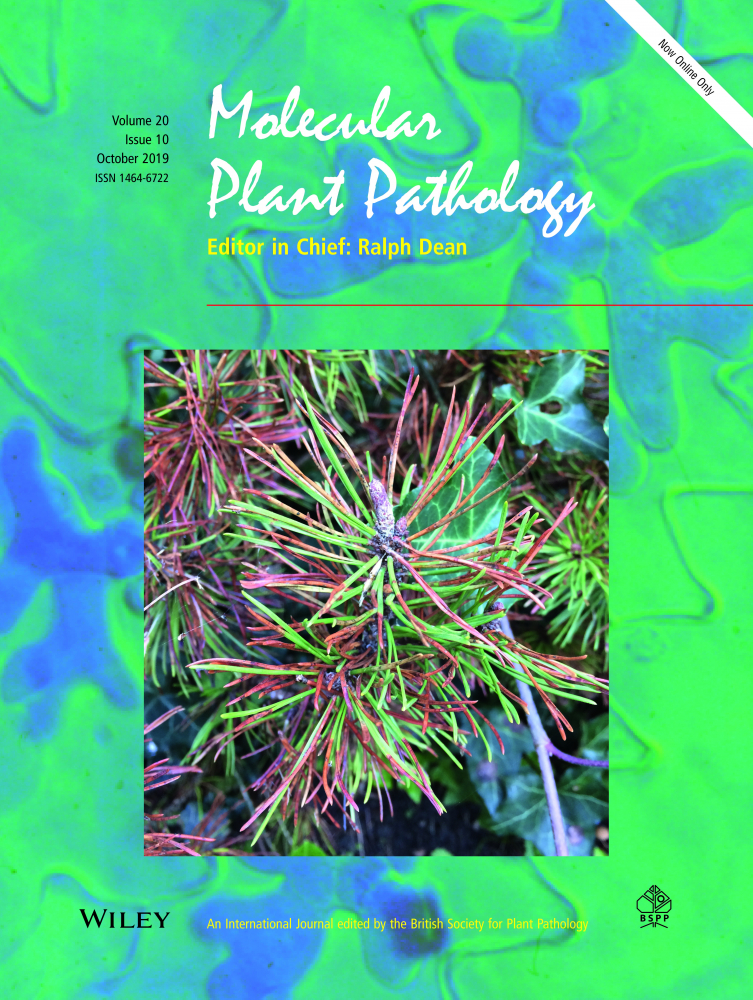 van der Nest A, Wingfield MJ, Janoušek J, Barnes I. (2019) Lecanosticta acicola: A growing threat to expanding global pine forests and plantations. Molecular Plant Pathology 20:1325-1474.
10.1111/mpp.12853 van der Nest A, Wingfield MJ, Janoušek J, Barnes I. (2019) Lecanosticta acicola: A growing threat to expanding global pine forests and plantations. Molecular Plant Pathology 20:1325-1474.
10.1111/mpp.12853 |
| van der Nest A, Wingfield MJ, Ortiz PC, Barnes I. (2019) Biodiversity of Lecanosticta pine-needle blight pathogens suggests a Mesoamerican Centre of origin. IMA Fungus 1:2
10.1186/s43008-019-0004-8 |
| Bradshaw RE, Sim AD, Chettri P, Dupont P-Y, Guo Y, Hunziker L, McDougal RL, van der Nest A, Fourie A, Wheeler D, Cox MP, Barnes I. (2019) Global population genomics of the forest pathogen Dothistroma septosporum reveal chromosome duplications in high dothistromin-producing strains. Molecular Plant Pathology 20(6):784-799.
10.1111/mpp.12791 |
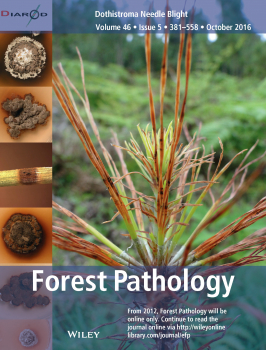 Barnes I, van der Nest A, Mullett MS, Crous PW, Drenkhan R, Musolin DL, Wingfield MJ. (2016) Neotypification of Dothistroma septosporum and epitypification of D. pini, causal agents of Dothistroma needle blight of pine. Forest Pathology 46(5):388-407.
10.1111/efp.12304 Barnes I, van der Nest A, Mullett MS, Crous PW, Drenkhan R, Musolin DL, Wingfield MJ. (2016) Neotypification of Dothistroma septosporum and epitypification of D. pini, causal agents of Dothistroma needle blight of pine. Forest Pathology 46(5):388-407.
10.1111/efp.12304 |


